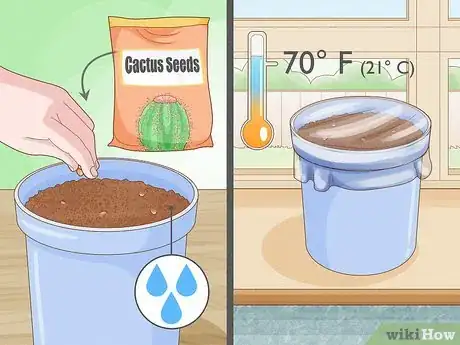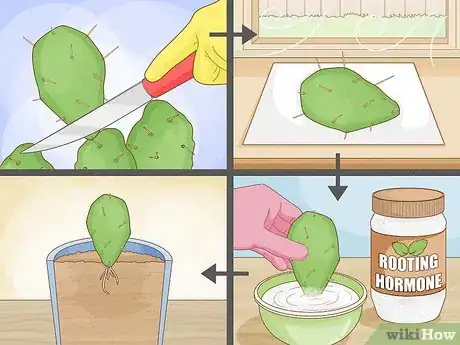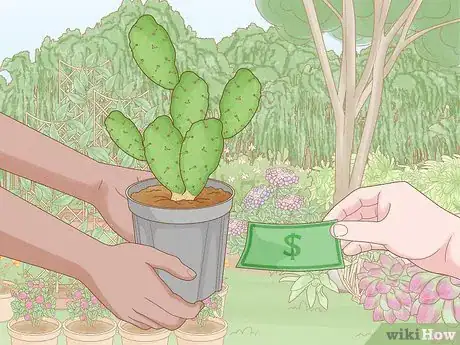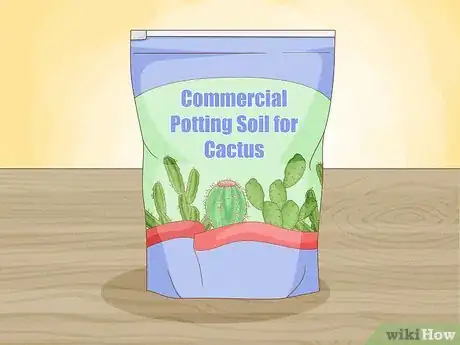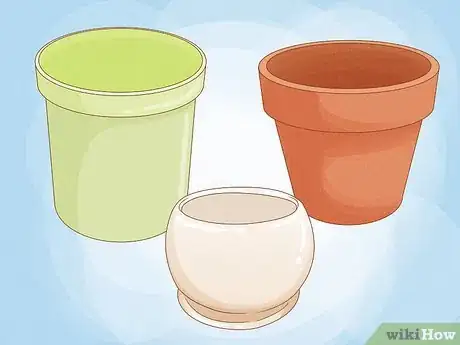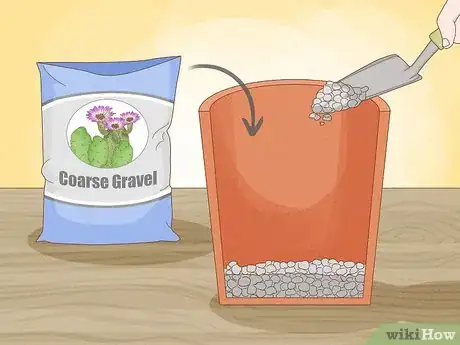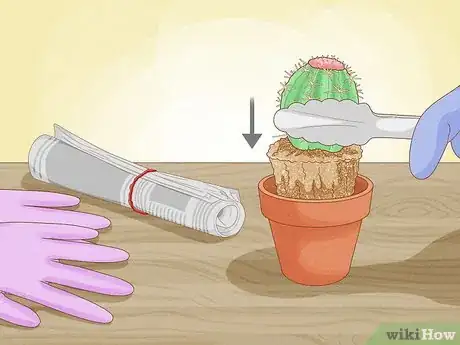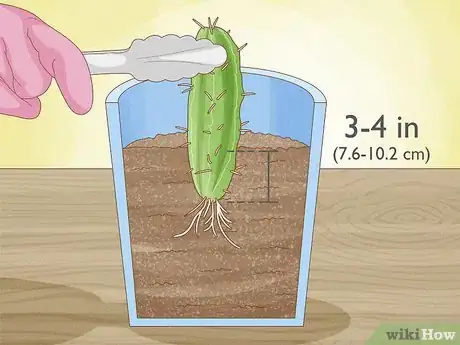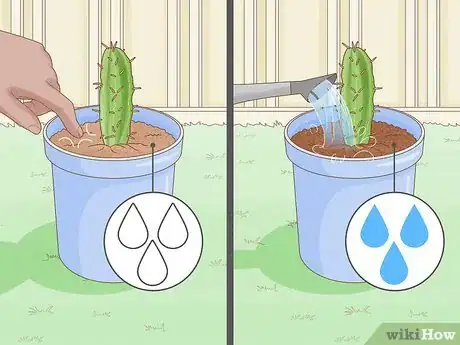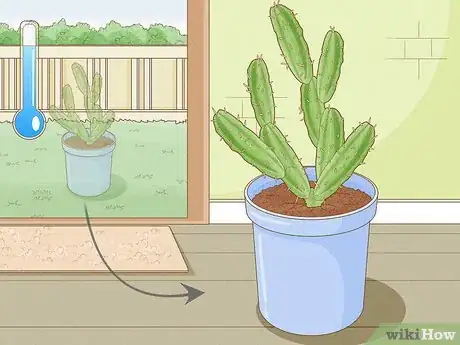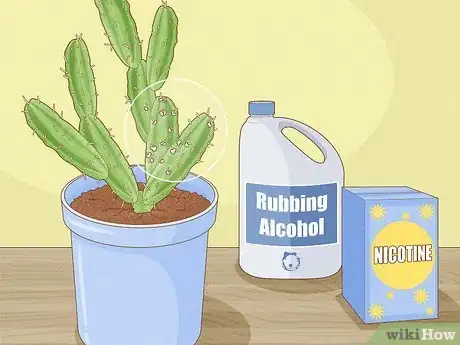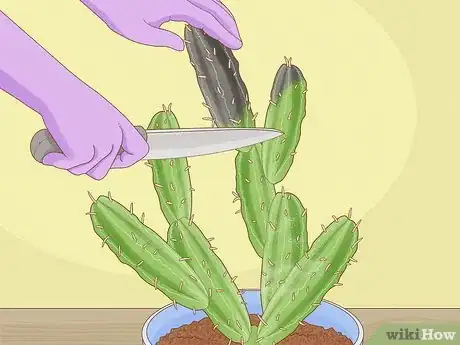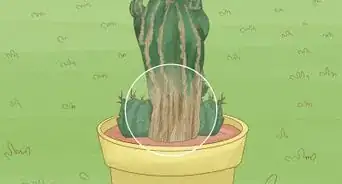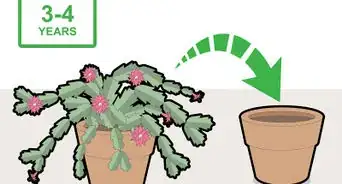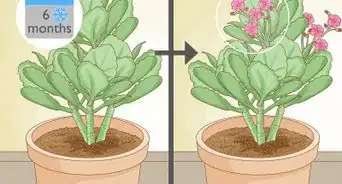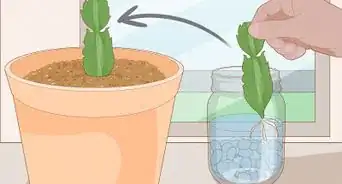This article was co-authored by Rachel Guffey. Rachel Guffey is a Plant Specialist and the Owner of Jungle House, a house plant shop based in Lawrence, Kansas. She specializes in plant education and caring for indoor plants. Rachel is passionate about using plants to help combat seasonal depression. She aims to make plants feel more accessible and approachable to everyone. Rachel has owned over 500 plants at one time.
wikiHow marks an article as reader-approved once it receives enough positive feedback. In this case, 100% of readers who voted found the article helpful, earning it our reader-approved status.
This article has been viewed 137,455 times.
Noted for its sharp spines and ability to thrive in hot dry places, a cactus is one of the easiest plants to grow in containers. They need little maintenance and make colorful, hearty houseplants. Cactus plants come in a number of varieties and shapes. Some have striking blooms. All cactus are succulent (meaning they can store water) and all are perennial (meaning they last for many years). However, it is still possible to experience failure, so knowing a few best practices for how to grow cactus in containers will ensure success.
Steps
Decide how to begin growing your cactus.
-
1Grow cacti from seed.
- While this method is not difficult, it can be time-consuming to see results. Cactus seeds could take up to a year to germinate and several years for the young cactus to begin to flower.
- Unless you have a heated greenhouse, it's best to sow cactus seed in the late spring. Seed companies often offer many mixed varieties of cacti seed.
- Use clean sterilized shallow pots to begin your seeds. Use a mixture of potting soil and sand. Place the seeds on the soil and cover them with just enough sand to anchor them. Keep in mind that cactus seeds don't germinate well if they have been sown too deeply.
- Dampen the soil enough to wet the seed. When the soil dries out completely, use a mister to keep it moist. Do not over water.
- Cover seeds with glass or plastic wrap and be sure to wipe away any condensation that may form. When seedlings appear, remove the cover. Carefully prick apart any seedlings that have grown together. Place the seedlings in light, but not in direct sunlight. Keep temperatures around 70 degrees F (21 degrees C).
-
2Propagate cacti from cuttings or offshoots taken from mature cactus plants.
- Allow the cuttings to dry and its cut edge to heal for a couple of weeks.
- Place the healed cutting into a rooting medium formulated to encourage roots to grow. Make certain the cutting is right-side up. If placed upside down, it will not grow. After a week, begin to water the cutting sparingly.
Advertisement -
3Purchase a cactus plant from a local garden center.
- Avoid plants with damaged spines or those that look bruised, spindly, or lopsided.
- Read the directions that come with the plant or speak to a professional about the best way to care for the type of cactus you selected to grow.
Choose the right potting medium for your cactus.
-
1Develop a potting mix consisting of 60 percent pumice (or perlite or vermiculite), 20 percent coir (or peat), and 20 percent topsoil.
- Add amendments such as time-released fertilizer and bone meal.
-
2Experiment with other potting mixes to find one that works best for you.
- Remember that cacti roots must have a well-draining porous soil which can easily be re-moistened. Some commercial potting soils have been developed specifically for cacti.[1]
Pick and prepare the right pot.
-
1Plant your cactus in an unglazed clay pot if possible because it will allow water to more easily evaporate. However, glazed clay, plastic, or ceramic pots may work as well for you if you are careful not to over-water as this could cause standing water in the pot.
- Wide pots are preferable to tall narrow pots which can cause stress to your cactus. Wide pots allow the shallow root system to spread out naturally while deep pots do not.
-
2Place coarse gravel or lava rocks in the bottom of your pot before adding the potting soil. Be sure the pot has good drainage holes.
- Avoid pots which are too large. Large pots hold water which can lead to root rot.
Plant your cactus carefully.
Ensure the best growing conditions for your cactus.
-
1Maintain very bright light for your cactus whether indoors and out.[4] Grow lights may help indoor cactus if your house is dark.
- Refrain from placing potted cactus in direct sunlight as it can become scorched and the roots will overheat.
- If your cactus is placed in full sun, use white or light-colored pots to help avoid overheating. Young plants will do best in partial sunlight.
-
2Water when the soil is dry. Let the soil your cactus is planted in dry out completely before you water it.[5]
- Simulate natural conditions in the desert by watering well but infrequently in much the same way as that of an infrequent desert thunderstorm. Over-watering will cause your cactus to rot.
-
3Maintain consistent temperatures. A cactus will go dormant if it is too hot or cold. Bring outdoor potted cactus indoors if temperatures are too cold.
Control pests and fungus which can harm your cactus.
-
1Treat scaly insect infestation with rubbing alcohol and nicotine. If roots are infected, remove the plant, cut off the roots and re-pot in sterilized soil.
-
2Cut out any part of the cactus affected by rot or mold before adding potting soil and beginning again.
- Dust the remaining parts with sulfur or a fungicide.
Expert Q&A
-
QuestionWhat's the proper way to water a cactus?
 Mark LeahyMark Leahy is a Plant Specialist based in the San Francisco Bay Area. He is the Co-Owner of Bella Fiora, a custom design floral studio, and SF Plants, a plant shop and nursery. Mark specializes in floral artistry and indoor plants including floral arrangements, terrace planters, office plantscapes, and living walls. Mark and his business partner have been featured in Vogue, The Knot, Today’s Bride, Wedding Wire, Modern Luxury, San Francisco Bride Magazine, San Francisco Fall Antique Show, Black Bride, Best of the Bay Area A-List, and Borrowed & Blue.
Mark LeahyMark Leahy is a Plant Specialist based in the San Francisco Bay Area. He is the Co-Owner of Bella Fiora, a custom design floral studio, and SF Plants, a plant shop and nursery. Mark specializes in floral artistry and indoor plants including floral arrangements, terrace planters, office plantscapes, and living walls. Mark and his business partner have been featured in Vogue, The Knot, Today’s Bride, Wedding Wire, Modern Luxury, San Francisco Bride Magazine, San Francisco Fall Antique Show, Black Bride, Best of the Bay Area A-List, and Borrowed & Blue.
Plant Specialist You want to let the soil dry out completely in between waterings. When you do water the cactus, water it very thoroughly.
You want to let the soil dry out completely in between waterings. When you do water the cactus, water it very thoroughly. -
QuestionHow much light does an indoor cactus need?
 Mark LeahyMark Leahy is a Plant Specialist based in the San Francisco Bay Area. He is the Co-Owner of Bella Fiora, a custom design floral studio, and SF Plants, a plant shop and nursery. Mark specializes in floral artistry and indoor plants including floral arrangements, terrace planters, office plantscapes, and living walls. Mark and his business partner have been featured in Vogue, The Knot, Today’s Bride, Wedding Wire, Modern Luxury, San Francisco Bride Magazine, San Francisco Fall Antique Show, Black Bride, Best of the Bay Area A-List, and Borrowed & Blue.
Mark LeahyMark Leahy is a Plant Specialist based in the San Francisco Bay Area. He is the Co-Owner of Bella Fiora, a custom design floral studio, and SF Plants, a plant shop and nursery. Mark specializes in floral artistry and indoor plants including floral arrangements, terrace planters, office plantscapes, and living walls. Mark and his business partner have been featured in Vogue, The Knot, Today’s Bride, Wedding Wire, Modern Luxury, San Francisco Bride Magazine, San Francisco Fall Antique Show, Black Bride, Best of the Bay Area A-List, and Borrowed & Blue.
Plant Specialist Your cactus needs bright light, so make sure it's placed near a window that gets good sunlight.
Your cactus needs bright light, so make sure it's placed near a window that gets good sunlight. -
QuestionWhy do my cacti look like they are turning white?
 Community AnswerSounds like it needs more light. When cacti don't get enough light, they turn a pale color and stretch out to the closest light source.
Community AnswerSounds like it needs more light. When cacti don't get enough light, they turn a pale color and stretch out to the closest light source.
Warnings
- Avoid frequent transplanting as that causes stress to your cactus.⧼thumbs_response⧽
References
- ↑ Rachel Guffey. Plant Specialist. Expert Interview. 5 August 2021.
- ↑ Rachel Guffey. Plant Specialist. Expert Interview. 5 August 2021.
- ↑ Rachel Guffey. Plant Specialist. Expert Interview. 5 August 2021.
- ↑ Mark Leahy. Plant Specialist. Expert Interview. 11 December 2020.
- ↑ Mark Leahy. Plant Specialist. Expert Interview. 11 December 2020.
- http://aggie-horticulture.tamu.edu/databases/cactus/growingcactus/
